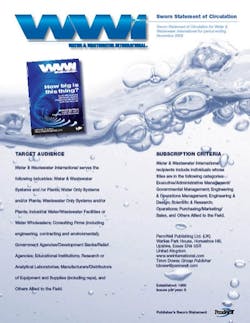News You Can Use
You may have noticed we at Water & Wastewater International are finding new ways to get you news and interesting articles that give you broader insight into the latest methods to achieve clean water and sanitation goals – and get it to more of you.
As well as our print magazine, which some of you hold in your hands right now, more today may be reading this via a digital version of the magazine that's available as a Smart PDF that you can download directly to your computer and peruse at your leisure, whether at the office or home.
In WWi's most recent Sworn Statement of Circulation – available online for this issue – you'll see not only a full breakdown of our readers by geographical region, industry type, job function, products and systems, purchasing influence, and population served by water system. You'll also see that we've basically more than doubled our circulation, from 11,000 to nearly 24,000 subscribers.
We've been doing these Sworn Statements for at least four years now as a testament to the strength of our circulation – you, the readers – and its professional influence. I believe we're the only publication in our market niche that reports its circulation in such detail.
In last year's statement, just over half of you preferred to receive WWi via print, with nearly 37% of total readers from Europe, 33.3% from Asia and the rest in varying percentages from the rest of the world: Mideast - 10.4%, Africa - 7.8%, South America - 5.2%, Asia Pacific 2.9%, North America - 2.4%. Today, about 75% of you receive the magazine via the Smart PDF digital version, with 38.4% of all readers from Asia, 32.3% from Europe, 7.7% from North America, 7.2% from South America, 5.6% from the Mideast and 2.8% from Asia Pacific. And numbers have jumped in all categories.
What does this mean?
By now, we all know the strength of the Internet. Digital delivery is more reliable than mail in most cases. With the digital version, we know right away whether the magazine was delivered, opened and downloaded. It's more immediate, i.e., readers don't have to wait a week (Germany), two weeks (Brazil), three weeks (Japan, Australia) or three months (Mexico) to get it. Being a Smart PDF, i.e., interactive, there are immediate clickthrough capabilities via hyperlinks on all web and email addresses, whether in ads or articles. All ads have direct lead generation reporting. And beginning with the last issue, hyperlinks to corresponding new items on our website are also available on select sections of the magazine, i.e., "Making Waves" headlines in the Worldwide News section and the Web Promo on the last page.
With a recent report from MediaDailyNews noting total ad pages at business-to-business publications fell 30.2% in the first half of 2009, we're also aware you readers are also authors and still want to get exposure for the technical articles, case studies and reports you write. So, we've add a Web Exclusive section to our Web Promo page where we post the many articles submitted to WWi that don't make it into print. These articles often get additional exposure via our monthly International Water Industry Report e-newsletter.
We're also proud our publisher, PennWell, has been a global leader in expansion of its publications' brands online. We pioneered webcasting, are about to do our first virtual web conference (sponsored by the Hach Company on Nov. 5), and have led the way with a comprehensive website (updated earlier this year to be more interactive), diversified e-newsletter offerings, and a networking community portal at community.waterworld.com (with its "Global Water Forum," and nearly 1,000 active members), as well as online video newscasts and tradeshow video interviews (see Pollutec 2007 and IFAT 2008 in our Video Gallery).
This isn't to say we'll ever go all digital, as we strongly believe print has a big place in the mix of ways in which people seek out information. For instance, a recent article from Next Communications Inc. pointed out that:
1. Two-thirds of online search users are driven do so as a result of an offline channel, i.e., magazines, newspapers, direct mail, etc.
2. Prints ads drive 30% of all online searches.
3. Site referrals from print represented 44% of leads on average.
It goes on to say: "Traditional media still represent the largest share of budgets in most cases, suggesting new media are mostly being integrated into the mix rather than totally displacing traditional approaches." I agree.
More Water & WasteWater International Current Issue Articles
More Water & WasteWater International Archives Issue Articles

